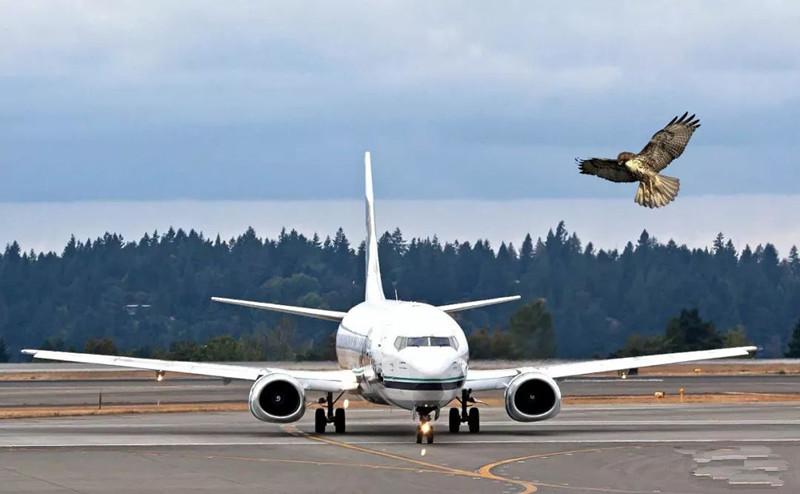1. What is a Bird Strike?
A bird strike refers to an aviation incident where an aircraft collides with a bird or a flock of birds. Bird strikes can cause considerable damage to an airplane, leading to costly repairs, delays, or even emergency landings.
While bird strikes may pose a lower level of risk compared to other aviation hazards, it is still crucial to take preventive measures to ensure the safety of aircraft and passengers. In the United States alone, bird strikes cost the aviation industry hundreds of millions of dollars annually. Implementing preventive measures can help reduce costs and prevent unnecessary damage to aircraft.
2. Most Common Birds
The specific species and size of birds involved in bird strike accidents vary from region to region. Birds of all sizes can be responsible for bird strikes, but larger birds like geese, gulls, and cranes can cause more significant damage to aircraft and pose a greater threat to aviation safety.
In recent decades, the bird population in the United States has continued to increase, resulting in a heightened risk of bird strikes. The Canadian goose population, for example, has tripled, increasing the potential for aircraft damage due to their larger size.
3. Factors That May Increase the Likelihood of Bird Strikes
Due to the substantial costs and risks associated with bird strikes, airports must implement preventive measures to reduce the risk. Several factors can increase the probability of bird strikes, including the altitude of the aircraft, the time of day, the environment surrounding the airport, and the migratory patterns of local bird populations.
Altitude:
Bird strikes are more likely to occur at lower altitudes, particularly during takeoff or landing.
Time of Day:
The risk of bird strikes is higher during daylight hours when birds are most active. However, according to the Federal Aviation Administration (FAA), nearly one-third of bird strikes occur at night when visibility is limited.
Surrounding Environment:
The environment surrounding an airport can have a significant impact on the risk of bird strikes. Vegetation and bird feeders near airports can attract more birds, increasing the likelihood of collisions. Additionally, airports located near bodies of water or agricultural fields may face a higher risk of bird strikes due to increased bird activity in those areas. Airports situated in areas that attract wildlife should proactively implement measures to repel birds and animals, thereby reducing the risk of collisions.
Migratory Patterns:
Migratory bird patterns can also influence the risk of bird strikes. During the spring and fall migration seasons, bird activity around airports significantly increases as many birds pass through in search of food and shelter. The FAA reports that over half of all bird strike incidents in the U.S. occur between July and October, during the fall migration, as more birds are on the move across the country.
4. How Birds Can Damage Aircraft and Impact Flight Operations
The impact of bird strikes on aircraft depends on various factors, including the size of the bird, the speed of the plane, and other variables. Smaller birds may cause minor dents or scratches, while larger bird strikes can shatter windshields or even disable an engine. Bird-induced damage to planes can also interfere with navigation systems and disrupt communication signals.
Engines:
Engines are particularly vulnerable to bird strikes as the weight and size of the birds can damage internal components. When birds are sucked into jet engines, they can cause bird ingestion, resulting in damage to the engine blades and a decrease in both airspeed and altitude. In some cases, bird strikes can even lead to engine failure, resulting in a loss of power and reduced control over the aircraft.
While most aircraft can continue flying on one engine, dual engine failure, though rare, can occur in certain instances. Notable examples include the well-known US Airways Flight 1549, where bird strikes resulted in the simultaneous failure of both engines. The aircraft successfully made an emergency landing in what became known as the "Miracle on the Hudson."
While dual engine failure is highly uncommon, any power loss can disrupt the security and safety of a flight. Taking proactive measures to minimize the risk of bird strikes is a worthwhile effort to avoid emergency landings and the subsequent costly repairs.
Windows and Windshields:
Bird strikes can compromise the structural integrity of an aircraft's frame, leading to expensive repairs or potential accidents. Since airplanes operate at high speeds, a collision during acceleration can result in a bird breaking through the glass of a windshield, endangering the flight crew.
Propellers:
In addition to engine ingestion, bird strikes can also damage propellers and reduce aircraft efficiency. The impact of a bird strike can cause the propeller blades to bend or break, resulting in decreased thrust and reduced lift.
Flight Control Surfaces:
Bird strikes can damage flight control surfaces, including ailerons, elevators, and the rudder. High-lift devices used during takeoff and landing can be susceptible to bird strikes, and if a bird becomes trapped in the mechanism, it can impede retraction. This can reduce maneuverability and affect the aircraft's ability to turn or climb in certain directions.
Nose Cones:
Bird strikes resulting in damaged nose cones can negatively affect an aircraft's performance and cause turbulence. A bird strike to the nose cone can reduce its aerodynamic efficiency, leading to increased drag and decreased overall speed.
6. How to Minimize Bird Strikes in Aviation?
Pestman bird repellents utilize biogenic repellent active ingredients, with the primary ingredient being Methyl Anthranilate (MA), a food-grade essence. MA is non-toxic, non-corrosive, and safe for birds, animals, humans, and the environment. Pestman bird repellent combines MA with other natural flavors to repel birds through smell, taste, and touch, making them highly uncomfortable. Consequently, the treated areas become undesirable for birds, preventing them from returning. Pestman bird repellent solely repels harmful birds and does not harm or kill them. Additionally, it can also repel bats and wild rabbits at airports.






